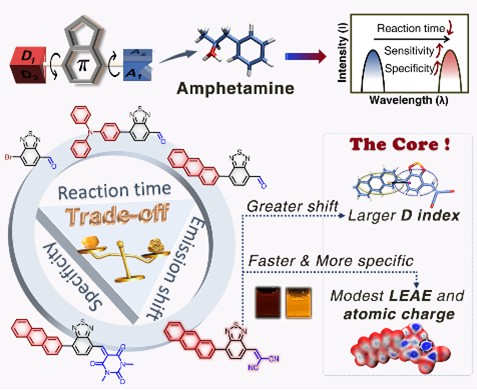Advanced Amphetamine Detection via Probe Structural Tuning
Editor: | Apr 27,2025
Amphetamine exhibits high addictive potential due to the pleasure-inducing effects caused by its promotion of dopamine release in the central nervous system. Owing to its diverse forms and high degree of camouflage, amphetamine abuse is on the rise. Consequently, the development of efficient and reliable methods for detecting amphetamine holds significant practical importance for safeguarding public health and maintaining social stability. Currently, the primary techniques employed globally for amphetamine detection encompass electrochemical method, mass spectrometry, Raman spectroscopy, colorimetric method, and fluorescence method. Among these, visualized sensing technologies, particularly those represented by chemical colorimetric and fluorescence methods, have garnered substantial attention due to their advantages of easily adjustable probe structures, intuitive detection outcomes, and user-friendly operation. To date, the recognition mechanisms of amphetamine can be categorized into covalent reactions and non-covalent interactions. Recognition driven by non-covalent interactions is prone to the interference from structural analogues, while the response rate of recognition dominated by covalent reactions is constrained by the formation and cleavage of chemical bonds. Therefore, enhancing recognition specificity and response rate for trace amphetamine visualization sensing in complex environments remains a critical challenge.
Aiming at the demand for comprehensive enhancement of on-site visualized detection performances for amphetamine, based on the nucleophilic reaction between the characteristic primary amine group of amphetamine and the electron-deficient site of the probe, the research team from the Xinjiang Key Laboratory of Trace Chemical Substances Sensing, Xinjiang Technical Institute of Physics and Chemistry, has proposed a design strategy for visualized probes based on the modulation of electron-donating and electron-withdrawing groups. This approach achieves simultaneous improvement in both response time and visualization effect for amphetamine detection. The study also reveals the positive correlation between response time and electrophilicity, as well as the number of positive charges at the recognition site, and the positive correlation between wavelength shift and the change in intramolecular charge transfer distance before and after the reaction. A sensing probe with fast response, high specificity, and significant visualization effect towards amphetamine was successfully developed. By immobilizing the probe onto a porous polymer substrate, the sensitivity and response time of the visual detection were further enhanced through the molecular aggregation effect, achieving a naked-eye detection limit as low as 0.1 mM and a response time as short as 1 min. The probe effectively distinguished amphetamine from 14 other common illicit drugs and amine derivatives, and it was successfully applied to the qualitative/semi-quantitative analysis of amphetamine in real urine and sewage samples. In this study, the trade-off effects among multiple sensing performances were reported for the first time, including the trade-off between reactivity and wavelength shift before and after the reaction, and the trade-off between reaction rate and recognition specificity. Furthermore, the mechanism by which probe molecular structure modulation influences sensing performance was elucidated, providing a theoretical and experimental basis for research on the comprehensive improvement of sensing performances via structural modulation of visualized probes, and offering a reference for the design of probes tailored for the visual detection of trace substances.
The related work was published in ACS Sensors entitled as “Highly Sensitive, Specific, and Fast Fluorescent Sensing of Amphetamine via Structural Regulation”.

Figure: Structural Modulation strategy for improvement of multiple sensing performances (Image by the group of Prof. Dou Xincun)
附件下载:
 (86) 991-3838931
(86) 991-3838931 lhskj@ms.xjb.ac.cn
lhskj@ms.xjb.ac.cn (86)991-3838957
(86)991-3838957 40-1 Beijing Road
Urumqi, XinjiangChina
40-1 Beijing Road
Urumqi, XinjiangChina